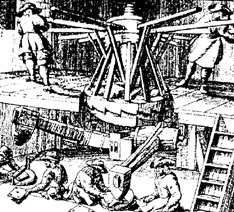

Striking coins with a klipswerk press was a slightly mechanised manual process. The upper die was attached to a frame aligned so it would hit the blank squarely. The "press" was what was commonly referred to as the screw press. In this coin press the upper die was fastened to a vertical moveable screw. A long, two-armed bar with a heavy ball at each end was attached to the upper end of the screw. During coining, the upper die was screwed down towards the bland by two or more workers setting the bar in motion.
The roller press had two rolls with several coin dies on each roll. Strips of coin metal, hammered to suitable thickness, were fed between the rolls. The coins were subsequently punched out in a separate machine. Coining in the roller press was a relatively fast procedure, but it was frequently less precise and more costly than the coining in machines based on hammering, or striking.






